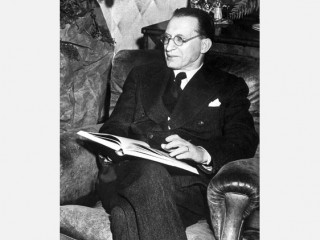
Alcide De Gasperi biography
Date of birth : 1881-04-03
Date of death : 1954-08-19
Birthplace : Pieve Tesino, Trentino, Italy
Nationality : Italian
Category : Politics
Last modified : 2010-11-16
Credited as : Politician and statesman, founder of the Christian Democratic Party,
The Italian statesman Alcide De Gasperi was one of the founders of Italian democracy after World War II.
Alcide De Gasperi was born on April 3, 1881, at Pieve Tesino in Trentino, then controlled by Austria. As a young man, he became active in the Irredentist movement to bring Italian-speaking people still under Austrian jurisdiction into the kingdom of Italy. In 1906 he began publication of the polemical journal II Trentino. This brought him a good deal of attention, and in 1911 he was elected to the Austrian Parliament as deputy for Trentino, a post he held for 6 years.
De Gasperi then joined the new Catholic People's party (Partito Popolare Italiano), founded by the Catholic political leader Don Luigi Sturzo. Trentino became part of Italy following World War I, and De Gasperi served as a deputy in the Italian Parliament from 1921 to 1924. Hard work brought him a position of eminence, and when Don Sturzo was forced into exile in 1924, De Gasperi became general secretary of the party.
As Mussolini's hold on the Italian government grew stronger, the position of the party became ever more precarious, and in 1926 it was dissolved. De Gasperi was imprisoned but was released 3 years later when, amid the atmosphere of good feeling between Mussolini and the Vatican, the archbishop of Trent intervened on his behalf. De Gasperi found asylum and temporary peace in the Vatican, where he studied Catholic social doctrine.
During World War II De Gasperi became active in the underground and was one of the founders of the illegal Christian Democratic party (Democrazia Christiana). He also founded the newspaper Popolo. After the liberation of Italy in June 1944, he served as minister without portfolio and then as foreign minister; in December 1945 he became premier, a post he held until 1953. As chief of the Italian delegation at the World War II peace conference, he elicited concessions from the Allies that guaranteed Italian sovereignty.
After the formal end of the monarchy in June 1946, De Gasperi functioned as head of the Christian Democrats, the party that dominated Parliament for the next 8 years. As premier, he gave moderate guidance that kept a precarious balance, during this critical postwar period, between disparate elements within the party and the nation. By avoiding conflicts with the numerous Socialists and Communists, he managed with great delicacy to put Italian democracy on a firm foundation. Besides his successful negotiations with the Allied Powers, his most striking achievement in foreign policy was the agreement with Austria (September 1946) to establish the southern Tirol as an autonomous region.
When the Christian Democrats did not gain a majority in the elections of 1953, De Gasperi was unable to establish a workable Cabinet and was forced to resign as premier. The following year he also had to forgo the leadership of his party, and 2 months later, on Aug. 19, 1954, he died.
Sources on De Gasperi in English are scarce. Elisa A. Carrillo, Alcide de Gasperi: The Long Apprenticeship (1965), covers his early life through his entry into the Quirinale as premier. Consult Denis Mack Smith, Italy: A Modern History (1959), for the political picture. English translations of the works by Luigi Sturzo that are helpful are Church and State (1939), Italy and the Coming World (1945), and Italy and Fascism (1967).
















